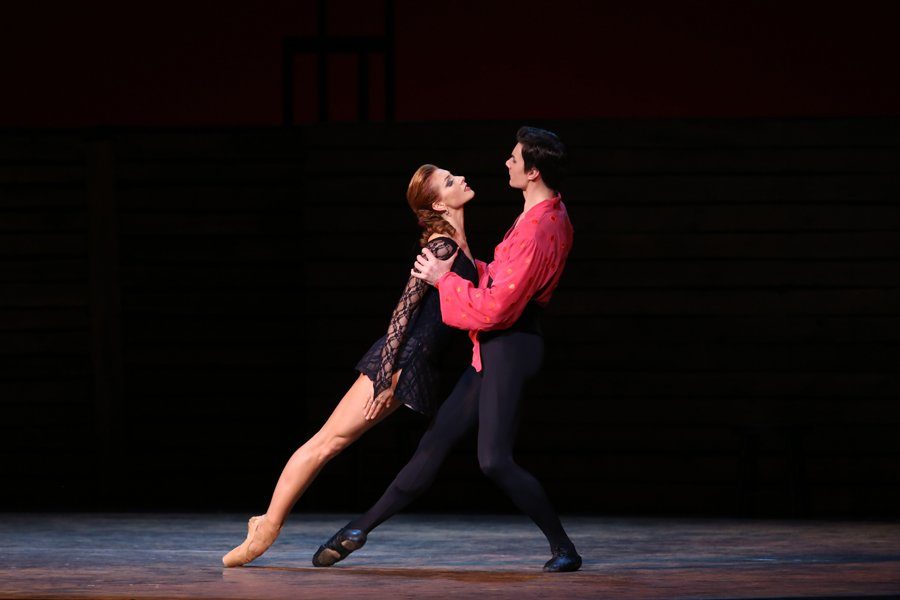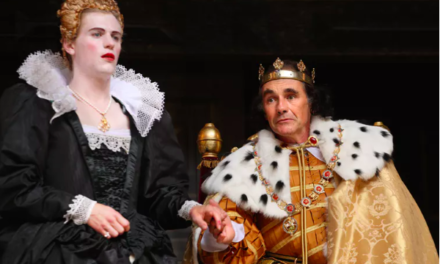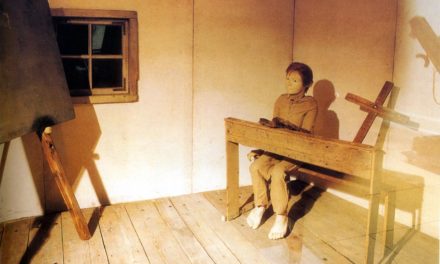In the last 20 years theatre has kept pace with changes in civil society in Russia. Society has changed a lot, and the total number of theatres has grown substantially since the 1990s. The reason for this renaissance of theatre is the rising economy and, as a result, the increase in the median income. After the want for tangible status, objects have been satisfied, people crave experience: theatre is in vogue now, and, on top of that, going to the theatre is considered to be sophisticated.
Theatre in general—and especially in Russia—is much more than an entertainment facility. It is the keeper of the national cultural and linguistic heritage, the source of inspiration and creativity, and the carrier of social values. One of the primary goals of the government is to provide all Russian citizens with access to these works of art. Prominent members of the cultural community such as Alexander Kolyagin, chairman of the Russian Theatre Union and director of the Et cetera theatre, have declared theatre a public good which organizes the social environment and that it is not a service measured by profitability. Theatre’s contribution to social capital is invaluable, which is why government support for theatre ought to be considered investment rather than spending.
Some facts and figures
According to the national statistics, the number of state and municipal theatres reached 651 in 2016. That same year, 87,553 people were employed as actors, stage crew, and administrative staff. The theatre companies used 1394 buildings, 20% of which were listed as cultural heritage. However, almost 25% of buildings were in unsatisfactory condition and in dire need of serious reconstruction. This issue is critical for regional theatres which cannot afford reconstruction and renovation of their facilities or some theatres actually fear that the buildings and premises where they are based might be taken from them by investors. The total capacity of the venues amounted to 234,028 seats. Only 2% of the seats were fit to be used by physically disabled people.
In 2016, almost 3,000 plays were played in the Russian state theatres. It amounted to 175,452 performances, including guest (17%) and tour performances in Russia and abroad (3%). Most productions were of plays by classic foreign authors of the 19 and 20th century and by authors of the Soviet era. The plays written by the modern Russian authors make only 17% of new drama productions. 1.7 billion rubles (25.8 million dollars) were spent on new productions.
For the 2015/2016 season, total attendance of theatres was 31.5 million. It is a depressingly small figure if we consider the Russian population—only 250 out of 1,000 people. One of the reasons for the low attendance is the scarcity of regional theatres. There are only 3.2 theatres for every one million people, and only 18.8% of Russian cities have at least one theatre. Moreover, almost half of the population lives in places where they cannot get to any theatre at all. Surveys show that 47% of respondents visit theatres rarely, while 29% of respondents have never attended a theatre in their life.
Legal status and government funding
As to their legal status, Russian theatres can be divided into two categories: state and municipal theatres, and private theatres. State and municipal theatres are again divided into non-commercial organizations, budget-based organizations, and state-owned or autonomous organizations; the latter being relatively new. Since 2007, some non-commercial and budget-based theatres in regions all over Russia were changed into autonomous organizations. State theatres can be also classified according to the authority they are dependent on: federal theatres, local theatres, theatres of the Ministry of Culture and theatres of other agencies. Private theatres can be both commercial and non-commercial organizations of various legal forms. In Russia, the role of personality in history is of critical importance. As a result, not only the economic but cultural well-being of the region, largely depends on the goodwill and resources of the governor.
State funding is the primary source of income for the majority of state and municipal theatres. According to the reports of the Ministry of Culture, their total 2016 budget was 81 billion rubles (1.3 billion dollars). Only 29% came from the own revenue of theatres while the major share of annual income proceeded from the federal (66%) and regional or municipal budgets (3%). For some theatres, the share of government funding exceeded 75% of the annual budget. Donations of sponsors accounted for slightly more than 2% of the theatres’ annual budget.
The unfortunate reality is that all state theatres are commercially unprofitable, and there is no exception to that rule. Even well-known repertory theatres running a significant number of performances in a season cannot make it to zero profit to cover expenses. If we rank state theatres according to the total income they get from all sources the chart-toppers will be the high-class theatres of Moscow and St. Petersburg: the Bolshoy theatre (Moscow), the Mariinsky Theatre (St. Petersburg), the Mikhailovsky Theatre, the Vachtangov theatre (Moscow), the Moscow Art Theatre (Moscow), the Variety Theatre (Moscow), etc. Some experts see the root of the problem in the lack of competition between state theatres. Trying harder to attract consumers would encourage them to improve the product, the same as with any other market.
An autonomous theatre receives funding via a government procurement contract, a so-called municipal task for a specific financial period (three years). Curiously, this form of support sets the theatre on the same level with other social services for residents. The list of services and the standards of their quality are defined by the federal agency in charge of the particular sphere area. In our case, it is the Ministry of Culture and the municipal Department of Culture. The theatre is obliged to produce a specified number of shows in total, mount a specified number of new productions, attract no less than a specified number of visitors and sell no less than a specified number of tickets. The list also includes the number of tours and guest performances, of participation in festivals, and of having provided services to disabled people. Quality of services is also measured by the percentage of the house capacity filled, the growth rate of audience attendance compared to last year, the percentage of audience satisfied with the provided service and other indicators. The agency calculates the costs for the planned work in advance and allocates a fixed amount of funding to get the work done. By the end of each year, the theatre reports the figures by filling the special form that covers all the parameters. The report is publicly available on the theatre’s web page. If the task is not accomplished 100%, funding may be reconsidered for the next period.
Other funding methods include subsidies and fellowships that are annually allocated to theatres in all regions of the Russian Federation. 600 state theatres are allocated regular subventions on an annual basis. Leading theatres receive grants from the President of Russia which are mostly spent on the salaries of actors and staff. Prominent artists receive personal grants to establish workshops and produce new plays. The Theatre Union of the Russian Federation conducts professional laboratories and schools to foster innovations and improve creative and management skills of staff members. Young people employed in the field of art get a monthly raise of 20,000 rubles (~283 euro) from the Russian government. 147 municipal theatres will be given 670 million rubles (9,477,000 euro) for the period of 2017–2020 to renovate their infrastructure, and to bear other expenses.
From time to time one government official or another will point out that approaches to the funding of state and municipal theatres ought to be changed from a fixed to a fellowship-based system so that more efficient theatres would get more money. It is not a trivial task since the criteria of efficiency for theatres have been the subject of hot debates. The whole optimization talk may be an attempt to further reduce the gradually decreasing amount of support for culture (which hardly reaches 0.5% GDP).
Some theatres already know that their future funding will be cut down and go through the trouble of providing some safety nets for themselves. The Mariinsky Theatre, for instance, uses its main stage all year round and closes it for reconstruction only for ten days during the summer. When the theatre is on holiday or on a tour, the stage is used by invited companies. The Fyodor Volkov Drama theatre (Yaroslavl) is ready to reconsider its staff schedule and to prioritize its renovation works. The number of performances and hosted international festivals will stay on the same level at any rate, though. Perm Youth theatre and Khabarovsk Youth theatre will have to turn down tours and postpone the planned increase in salaries. However, they are optimistic and are ready to contest for external grants and projects and use internal resources more efficiently in the production of new plays.
Festivals and tours
Theatre festivals are a bright and distinguishing feature of the Russian cultural scene. According to the Russian Union of Theatre Actors, 256 festivals of various art forms are held annually in almost 100 cities. The most well known are the Golden Mask, the Chekhov theatre, as well as other festivals that take place in Moscow. Regional Russian theatres regularly host versatile festivals from Europe.
Theatres from central cities and regions frequently give guest performances in other regions during the summer. Touring shows add considerably to local repertoires, increasing and diversifying them, providing a wider choice for the audience as the usual repertoire of a regional theatre is 10–15 shows running year in and year out. Travel expenses for tours abroad are compensated either by the Russian Ministry of Culture or by the host country. In 2014, a program called “Big Tours” (Bolshie gastroli) was established. It promotes tours of federal theatres and theatres of the Ministry of Culture to regions. Plays for a young audience are especially welcome because commercial tours consider them as unprofitable and do not usually include them in their programme. The goal of the programme is to make theatre shows available in the regions which don’t have enough funds to invite theatres on their own. In 2017, the tours are to cover 45 regions of the Russian Federation, 70 cities in total. The federal government compensates the theatre and covers its travel expenses, while the regions are in charge of the accommodation costs and the technical rider. Ticket pricing policy is also left to the regions.
Youth theatre
Youth theatre for children and teenagers is a highly regarded art form in Russia. The theatre is one of the crucial channels of socialization and cultivation of artistic and creative taste. The effect that first positive impressions have on the forming of the future appetite for arts is invaluable. It is important for a youth theatre to talk about important topics, such as tolerance, loneliness, and suicide. In 2016, 11% of state and municipal theatres were youth theatres while almost 70% of guest performances in other regions were productions of plays from the youth theatre repertoire. 57% of performances given by state and municipal theatres were targeted at a young audience. At 39 festivals, the total number of youth festivals in Russia is quite substantial. In 2017 and later, youth theatres will get approx. 4.2 million euro annually from the state. Approximately 3 million will be divided between regional and municipal youth theatres. The funding will be primarily aimed at new productions to diversify the repertory.
There are lots of theatres for younger children, including puppet theatres; at the same time, there is still a lack of theatres for teenagers or 12+ audiences. Despite the fact that lots of repertory theatres have performances based on literature from the school curriculum in literature, there are still problems that are important for teenagers but are not featured in plays. Teenagers have definitely grown out of fairy-tales with saccharine heroes fashioned to fit the Soviet didactical “Tuyz” (Theatre for the young audience) manner. However, adult issues in dramas may seem too complicated. Long-windedness and a patronizing manner should be avoided under any circumstances.
Recently youth theatre has been infused with new blood—some young directors who are not shy of experimenting, have joined the field. In 2016, the eminent festival “Golden Mask” established a separate section for youth theatres, the Kids’ Weekend, that showcases productions for every age: from toddlers to teenagers. Sixteen shows from various regions of Russia included in the programme yielded a high attendance rate.
Private youth theatres are usually small-scale and mobile. They often play at schools, kindergartens, and other education centers because they cannot afford to rent a proper venue with a stage, and their scenery is usually easily transportable. Some of them have regular tours in Europe. When a small youth theatre and a large drama theatre work together, it may be very fruitful and blend fresh ideas with funds. Theatres have opened up the laboratory of youth theatre where young directors have a chance to put on new plays of contemporary playwrights. The Meyerhold center established a program “The Meyerhold Centre for Children,” where actors put a young audience in touch with the art of telling literary texts.
Private theatres: spectacle or laboratory
Private theatres get support through project financing, and they may also contest for state financing. In 2016, 43 private theatres from St. Petersburg got 496,000 euro funding from the City Department of Culture. Non-financial support, such as providing additional venues, is also a great help, as the rent accounts for the lion share of fixed costs. It also includes preferential loans, insurance, social waivers, etc. However, such support creates a tricky interdependence between the theatre and the government. Some government officials use the threat to cut the support or to demand a much more detailed report on used funds, as leverage and as a means to control the repertory of an independent theatre. This is the case of the Theatre.doc and theatre studio under the guidance of Kirill Serebrennikov.
Apart from the stage activity, theatres raise money from event management, film production, participation in concerts, etc. Some theatres attract sponsors who give money on new theatre productions in exchange for advertisement, or request discounts from energetic companies in exchange for tickets. Other theatres receive regular donations from entrepreneurs, like the Sergey Zchenovach Theatre.
Small-scale theatres spark with innovative and contradictory productions and imaginative ideas but are short of capital. On the contrary, non-repertory companies are profitable and successfully compete with the repertory theatre. Some non-repertory companies, like the Anton Chekhov theatre, the Independent theatre project, the Art-Partner XXI, the Quartet ‘I,’ and others have been on the theatre market for more than ten years. Their reasons for success are obvious. Theatres cater to the tastes of a mass audience. There are usually one or two hits in the season, comedies, romance, and detectives with star actors in leading roles. Half of the performances are played in another region. Theatres economize on the number of employed actors (not more than seven/eight per performance), on the rehearsal period, on scenery (no complex pivotal element), on rental costs (going from one rental venue to another), and maximize the revenue from box sales (the stage hall not smaller than 700–1000 chairs). The engagement process is much simpler since actors are contract workers.
Amateur theatres
Amateur theatres are financed by their participants, volunteers and through crowdfunding. They may seem insignificant and hardly worth to be mentioned when we speak about professional theatres, but these tiny art groups are the basis of any theatrical activity. Amateur theatres sometimes conceive new initiatives and practices and, like caterpillars transforming into butterflies, evolve into professional, albeit small, units, and establish their own culture niches. Stanislavsky himself and his troupe started putting on amateur performances on the home stage of their mansion.
Amateur theatres often engage semi-professional actors, such as students of theatre schools, who will participate just for the fun of it and to practice. Sometimes they get a place free of rent for rehearsals and performances in exchange for teaching children and participating in municipal cultural events. In some aspects, amateur theatres may well exceed expectations and adhere enthusiastically to professional ethics and best practices. For instance, the Fellowship Art Group in Moscow successfully purchased official licenses for the production of German and American musicals (Rebecca; Tick, Tick,…Boom!; I Love You, You’re Perfect, Now Change). As a half-professional theatre, they got a discount on rights by declaring a limited number of shows. In artistic aspects, however, no discounts were made: the scripts were translated into Russian; shows involved actors with decent vocal and artistic skills that had auditioned for the play, there was live music and a modest but stylish scenery.
Conclusion
Traditional or repertory theatre has been known in Russia for two centuries now. Having a permanent ensemble is the cradle of innovative art and improves the traditional art. Distinguished artists pass their skills to younger actors in the course of the intensive work interaction. It will be long until the theatre depends less on the government funding. Without support, traditional theatre would have merely an entertaining role and would have a limited repertory. People in small cities would be even farther away from having a touring theatre in their vicinity since they don’t have any buildings spacious enough to serve as venues where a commercial company would care to perform.
Live art is in eternal motion and in a constant search for balance. Formalistic and matter-of-fact practices are not what theatre needs. Vladimir Vysotsky, iconic Russian bard and, by the way, the actor of the Taganka theatre, sang about the rope-walker:
The theatre is taking the long and winding road to the future. We are lucky to witness its transformation to something, even more, awe-inspiring.
Oxana Bondarenko is an experienced researcher in applied economics. She gained deep understanding in such fields as trade and regulatory policy, corruption, agriculture, budget reform, culture policy. Bondarenko has analyzed the effect of films on trust and altruism and has investigated price strategies of theatres and demand on theatre tickets for the Russian Ministry of Culture, reviewed articles on the economics of theatre for two academic journals. Bondarenko’s academic interests lie in the field of economic psychology. She is a PhD student at the Higher School of Economics and conducts laboratory experiments to study economic models of the rationality of the human behavior. She also acts in amateur musical theatre.
Emiliia Dementsova is a theatre critic, lecturer and the script editor-in-chief at the cinema company Sputnik. She is a PhD candidate at the Lomonosov Moscow State University and is also a member of the International Association of Theatre Critics, and the Russian Union of Journalists. Dementsova has acted as a cultural columnist for Critical Stages, European Stages, The Hollywood Reporter, Komsomolskaya Pravda, Theatron, Theatre World, among others. She is a scholar of the Oxford Russia Fund. She received the International Press Club award called Challenge – XXI century for a series of theatre reviews she authored and Russian national literary award “Golden Feather”.
This article was first published on conflict-zones.reviews. Reposted with permission of the author. Read the original article here.
This post was written by the author in their personal capacity.The opinions expressed in this article are the author’s own and do not reflect the view of The Theatre Times, their staff or collaborators.
This post was written by Oxana Bondarenko and Emiliia Dementsova.
The views expressed here belong to the author and do not necessarily reflect our views and opinions.

















